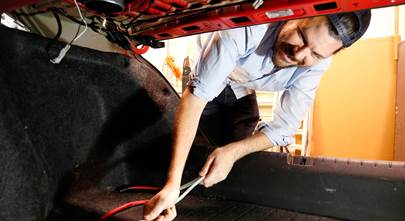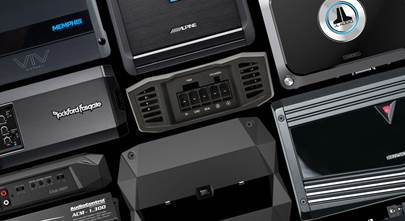Putting Dynamat to the test in a Ford F-150
Our Car Stereo Proving Ground Series, part 4

We set out on a 5-month mission to create the ultimate system in a 2004 Ford F-150. With all the gear in place, it was time to battle road noise. Dynamat products minimize vibrations, block road noise, and absorb sonic reflections. By quieting all that noise, we were able to hear every last detail of the system we built.
John, one of our car audio writers, jumped at the opportunity to tear apart the F-150.
Watch the video about this project.
Reducing road noise with Dynamat
Vibrations from your car’s engine, chassis, and the road manifest themselves as audible noise in the cabin, which makes it tougher to hear details in your tunes. If you put time and money into building a system, you don't want it to be drowned out by the pavement. Jeff attacked the road noise issue with plenty of Dynamat — his system deserved nothing less.
Normally, you’d add Dynamat as you're putting in your speakers and running wires, but we did it last on purpose to show just how much of a difference in the sound pressure level (SPL) of road noise some damping can make. Jeff knew his truck had some rattles and resonant frequencies that were detracting from his sound, so Dynamat was a big part of his overall plan. And in keeping with the spirit of this project, he did as perfect a job as possible.
How much do I need?
Good results, even with partial coverage...
The minimum coverage recommended by Dynamat for basic resonance control is 30% of the area of any panel when using Dynamat Xtreme. Do that, and you’ll hear a difference.
...or get great results with full coverage
Of course, while a little Dynamat goes a long way, more is better. In fact, Dynamat says that complete coverage of an average vehicle can reduce road noise 9-18 dB. For reference, a 10 dB drop cuts road noise in half.

Adding dynamat to the doors
Jeff has a fantastic set of Focal component speakers in his doors, and they needed a sonically-sealed home. When his truck rolled off the assembly line, it had just a thin sheet of plastic to combat road noise. Rattles, vibrations, and resonant frequencies easily stole some thunder from Jeff’s speakers. So it was Dynamat to the rescue — he stuck it to every available square inch of his door. “A lot of energy is transferred through the doors,” Jeff says. "That’s the best place to start with Dynamat."

Dynamat Xtreme door kit
Doors are the trickiest places to apply Dynamat, since there are a lot of small spaces to navigate. Fortunately, you can cut out custom-sized pieces with a utility knife. The Dynamat Xtreme door kit comes with four 12" x 36" sheets (12 square feet), plenty for two doors.

Just adding Dynamat to the doors decreased the road noise by 2 dB.
Quieting the Floor
Jeff started by removing his seats and carpet. Then he put down a couple of layers of Dynamat Xtreme, followed by a layer of DynaPad (plus a little Dynaliner when he ran out). Man, was it nice to quiet down the noise coming through the floor — we really noticed a difference when driving over a dirt road. And here’s a nice bonus: the DynaPad feels pleasant underfoot, too.
Jeff had a lot of area to cover, so he opted for the bulk package of Dynamat Xtreme. It gave him 72 square feet to work with.
Jeff used these on his floor, too:
Dynamat DynaPad – DynaPad is a kind of acoustic foam “sandwich” that throws a layer of acoustic barrier material between two layers of sound-absorbing foam. It lies under your vehicle’s carpet.
Dynamat Dynaliner – Dynaliner helps absorb noise in your vehicle. Use it on top of a layer of Dynamat Xtreme for best results.

At this point, the truck is noticably quieter.

The DynaPad “sandwich”
Since DynaPad goes on the floor, it needs to be substantial in order to stand up to road noise and exhaust-system heat. Most people react the same way the first time they pick up a chunk of DynaPad: "Wow, that’s heavy!"


Sealing the cabin and hood
A layer of Dynamat Xtreme and Dynaliner went under his headliner, and Hoodliner went under the hood. Jeff’s got his rattles and engine noise under control now. He’s turned the F-150’s interior into a much quieter space for listening to tunes.

Even better on a dirt road
Wow, what a difference — we measured a huge 16 dB drop when driving on a dirt road. Other than the bumps, it was like riding on pavement had been before the Dynamat was installed.

Dynamat isn’t just for cars!
Dynamat helps stop rattles wherever they occur. We asked around Crutchfield headquarters and found employees using it for all kinds of things: wrapping it around a noisy HVAC duct, treating a washer and dryer, eliminating a buzz in an old guitar speaker cabinet...the only limit is your imagination. If it’s rattling, try some Dynamat.

What did we learn during this last round of testing?
Dynamat is fantastic stuff. Riding in Jeff’s truck after installing all the Dynamat products was an interesting experience after having ridden in noisy cars for so many years — for one thing, it wasn’t necessary to shout in order to hear one another. And since he doesn’t have to compete as much with road noise, Jeff doesn’t have to crank the volume as high.
"You can’t build the ultimate sound system without addressing road noise," he says. "Dynamat makes a huge difference."
Learn more
Catch up on parts 1-3 here.












Eddie Mikell from Charlottesville
Posted on 2/18/2021
It's funny Crutchfied has all these positive test. I went by last week to get an estimate on having sound dampening put in my car. The technician on duty sad it would be a complete waste of money, so not sure why this video is released since they don't support what they say in this video.
Alexander H. from Crutchfield
on 2/22/2021
Trevor from North Bay ,Ontario,C
Posted on 9/12/2020
Wonder if something else can replace dynamat seeing its pricy..how about water and ice sealent for roofs rubbery sticky backing maybe 3/16" thick and could do 5 complete cars with a roll for $200
Jimmy from Rochester
Posted on 4/4/2019
Are the SPL readings A weighted or C weighted? It looks like most of the reduction was from the roof? Anyone know if deadened can be applied to a ceiling of a car that has rear air vents in the ceiling?
Alexander Hrabe from Crutchfield
Posted on 3/5/2018
Doug, naturally you should use your best judgement re: any value issues that may come up with the resale of a vintage vehicle, as Dynamat is not easy (nearly impossible) to remove. Applying it to metal should be fine, but I wouldn't apply it to any non-metal elements of a vintage door like vinyl, fabric, brittle plastic, etc. It's fairly heavy, and the strain on old, non-metal surfaces could be too much.
Doug from Sunriver, Or
Posted on 3/4/2018
I have an older 1970's ford truck needless to say the road noise is nothing short of extreme, that being said I used Dynamat in newer vehicles on the inside face of the door panels many times, my thought on this 1970 Ford truck is this: would there be any advantage/ disadvantage to applying Dynamat to the interior door skin? This truck has the unique advantage of being able to remove the factory inner door panel, allowing nearly full access to applying Dynamat to the interior of the door skin. My immediate concerns with doing that is: very cold freeze-thaw cycles, rain water, future auto body damage etc... any thoughts on doing this?
Chris from Trenton
Posted on 9/15/2017
One of the Problems with using Dynamat stuff is, Sometimes the Panels wont "Seat" properly. Due to the extra thickness. And the Smell of Asphalt. Using the older products. Then comes the Hassle of removing it when say the Window Motor/Regulator goes bad.
Alexander Hrabe from Crutchfield
Posted on 9/5/2017
Mick, the firewall is usually pretty well insulated, especially in nicer vehicles. But if you get a lot of noise from the engine in the cab, then installing a sound deadener like Dynamat could certainly help. It's more advisable that you install it on the firewall inside the cab.
Mick from columbus oh
Posted on 9/3/2017
didnt see any mention of installing sound deadening material to firewall under hood. Why under the hood. Seems like that noise would not penetrate to the car interior. advise
Alexander Hrabe from Crutchfield
Posted on 2/10/2017
Mike, I've passed your question along to an advisor. Someone will contact you soon to answer any installation-specific questions that you may have about Dynamat.
Bobby
Posted on 2/9/2017
To help out Mike (comment above this one), I believe the Dynapad used in the F-150 in the article is in fact a specialized product that combines together two layers of heavy foam and one layer of vinyl or something similar sandwiched in the middle. Dynaliner I think is just the foam. The foam in Dynapad and Dynaliner isn't exactly foam "board" though, but it is a specialized foam intended for noise reduction. So if you use Dynamat and Dynapad as they did, you should cover your 3 criteria above (except with foam instead of foam board). I myself haven't heard of people fitting in a vinyl layer anywhere except the floor, but I'm not sure / not an expert. I myself just used Dynamat and Dynaliner on non-floor surfaces.